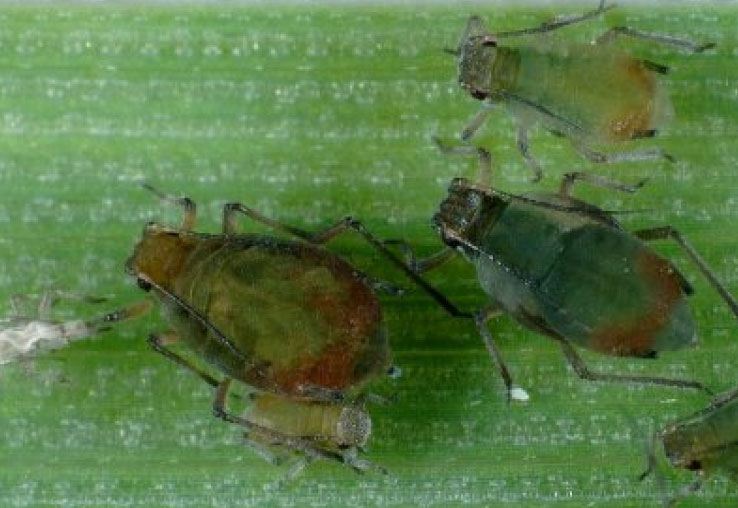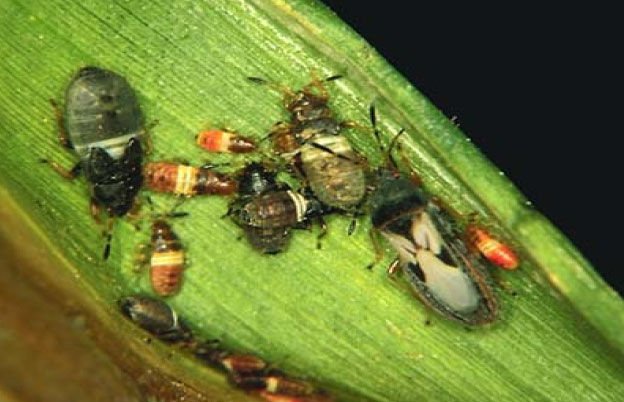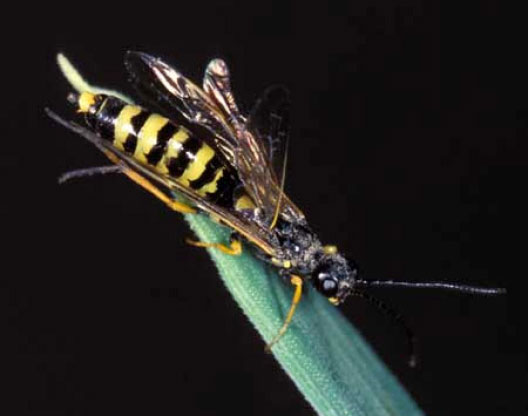Insect Management


Aphids
Aphids are small, soft-bodied insects that obtain their nutrition by sucking sap from plants. They have two cornicles that protrude from the upper surface of the abdomen near the tail. These “tailpipes” vary in length and may be reduced to mere bumps in some species. During feeding, aphids inject salivary secretions into plant tissues. The salivary secretions of some aphids are toxic and can cause severe tissue damage in the plant. Symptoms of aphid injury include leaf stippling, discoloration or striping. In addition, wilting, premature browning and death of the plants may result.
Management: Controlling volunteer wheat, avoiding early planting of winter wheat and maintaining a healthy crop will help minimize risks. Monitoring aphid populations in the fall and spring and following treatment guidelines are necessary to minimize the risk of serious losses.

Chinch Bugs
Newly-hatched bugs are small and bright red. All life stages feed on susceptible grass plants between the leaf sheath and stalk. They are red to brown with a white band across their backs during the first four stages. The fifth nymphal stage is nearly black, with a white spot between the developing wings. Chinch bugs have piercing-sucking mouthparts at all stages. They injure host plants by sucking plant juices. They have a characteristic musty odor that is detectable when large numbers are present or when the bugs are crushed.
Management: Integrated program of careful crop management and insecticide application

Hessian Fly
The Hessian fly passes through two generations per year in which adult flies deposit eggs; maggots hatch on the leaves and feed on the stalks; and, after feeding, the maggots pupate into a form commonly recognized as flaxseeds. The flaxseed pupae can often be located near the infested tiller in the spring or associated with broken stems observed in the early summer.
Management: Plant varieties that are resistant to the Hessian fly and plant wheat in the fall after the late summer adult egg laying period has passed.

Wheat Curl Mite
These mites are wingless, cigar-shaped and approximately 0.2 millimeters in length. Unless found in extremely high numbers, these mites generally cause little direct damage in the field other than the characteristic leaf curling and the occasional trapping of the flag leaf. However, both immature and adult Wheat Curl Mites transmit Wheat Streak Mosaic Virus.
Management: Chemical control of mites is believed to be largely ineffective as they predominantly live within leaf whorls. Volunteer wheat and grasses should be destroyed at least 10 days prior to planting in the fall to limit vector survival.

Wireworms
These insects may spend the winter as adults or larvae. Adults are about 1/4 to 3/4 inch long, hard shelled, brown to nearly black with a streamlined body. The adults are called click beetles because when they are on their backs, they will flip up and turn over with a clicking noise. Larvae live from two to six years in the soil feeding primarily on roots. Wireworms eat the germ of the seeds or hollow them out completely, leaving only the seed coat
Management: Wireworms are among the most difficult insects to control. Planter box insecticide seed treatments will reduce damage to the seeds, but will not protect seedlings.

Sawfly
The adult sawfly is a slender wasp about 1/2 inch long with a black abdomen and yellow ringed markings. When observed in the field, sawflies may be recognized by the unusual habit of resting head downward on the stems of grain plants. Sawfly damage is threefold. First, they cause grain yield reduction by their tunneling activity in the infested stems. Additional loss occurs when sawfly-cut stems fall to the ground and become unharvestable. The protein content of grain from the infested stems is also lower.
Management: Crop rotation, delayed planting and fall tillage.

Armyworms
In autumn, fall armyworms may be a problem in seedling plants. Fall armyworms feed on the young plants and eat the plants to the ground, causing a loss of stand. Damage of this type may occur from emergence until a bad frost or freeze eliminates the threat of armyworms. Wheat will usually recover from moderate fall armyworm damage. In the spring, true armyworms are a threat about the time heading begins. Wheat is very attractive to the armyworm, and thick, vigorously growing fields can attract high infestations. Occasionally, when wheat starts to mature, armyworms will move up from leaf feeding and cut the wheat heads from the plant stem.
Management: An infestation level of five to six worms per square foot will justify treatment. Treat only with liquid insecticides during the warmer part of the day.

